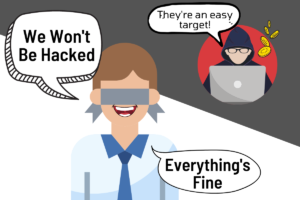When it comes to your business, the cost of ignoring your cybersecurity is exponentially greater than simply investing in the proper protection up front. Without the appropriate layers of security, you’ll find yourself buried in the costs of ransomware and its long-lasting effects.
You have two choices:
1) Invest in the right technology, systems, and policies that will work together to prevent ransomware and other attacks.
2) Ignore the problem and hope that a breach never happens to you — and then have to pay up front when it does happen.
While it can be tempting to “cross that bridge when you come to it,” investing in cybersecurity is less costly for your business than trying to damage control later.
But, what does that damage control look like? And just how disastrous can a cybersecurity breach be?
Let’s look at the real cost of going with option #2 and choosing to ignore your business’ cybersecurity needs.
What it Means to Be a Victim of a Ransomware Attack
Ransomware is a form of malware that encrypts your files, making it impossible to access them without first paying the attacker a ransom. Once the ransom is paid, the attacker restores access to your most valuable data. That ransom can cost you thousands of dollars.
Getting infected with ransomware is relatively easy. It can be as simple as clicking on an attachment in an email that’s supposed to look legitimate when in fact it’s a direct pipeline to the malware.
While it is possible to remove ransomware from your machine, it’s not possible to regain access to your data without paying the ransom. Once a ransomware attack has occured, your files are encrypted for good — and no amount of removing the malware will allow you back into them without the access code that the attacker holds.
It goes without saying that losing access to all of your files is a blow almost no business can recover from. In mere moments, you’ve lost your most valuable data — from customer records to point of sale systems to important financial and business continuity documents. All of it can be gone in a flash.
What Happens Next?
According to a survey conducted in 2017, every other company who participated in the poll had experienced a ransomware attack in the previous 12 months. Some had even had an attack on multiple occasions. 79% saw their systems infiltrated due to these kinds of social engineering attacks.
It’s safe to say that attacks like these are possible — and they can happen to you. If you find that you’re the victim of a ransomware attack, what happens next can make or break your business.
Step 1: Pay the Price
You have to pay the price in one way or another. You have the option of either A) paying the ransom, which does not necessarily guarantee you will regain access to your files or B) wiping your systems and starting over, potentially costing you all of your business’ data if you don’t have layers of backups and security in place.
Step 2: Report the Attack to the Local Authorities
The police can help identify the attacker and help prevent other businesses from falling for a similar attack.
Step 3: Cleanse Your Systems
The best plan of action is to completely wipe your storage devices and start fresh, reinstalling everything. This is the only way to ensure there aren’t any traces of the ransomware left in your systems.
Step 4: Restore Your Data
In a perfect world, you have backups of your data that can be used to restore your systems. In a not-so-perfect world, you are completely without your data and have to start from scratch, costing you inordinate amounts of time, money, and resources.
The Best Course of Action
All in all, being the victim of a ransomware attack or any cybersecurity threat is a huge headache. You run the risk of not only costing your business thousands of dollars, but losing the faith of your employees, becoming viewed as a less trustworthy company, and even facing the consequences of fines and citations due to lack of security compliance.
The up front cost of investing in cybersecurity is so much lower than trying to damage control later. Proper cybersecurity means that you’ll have backups of your data, layers of protection in place to prevent malware from taking hold, and expert training for you and your staff so that attackers have less of a chance of getting through.
Investing in managed cybersecurity is one of the best ways to cover all of your bases. You owe it to yourself and your business to take cybersecurity seriously so that you’re never taken by surprise when an attack occurs. With the right systems and strategies in place, you’ll be back up and running in no time — without ever having to deal with the fallout from a major attack.


